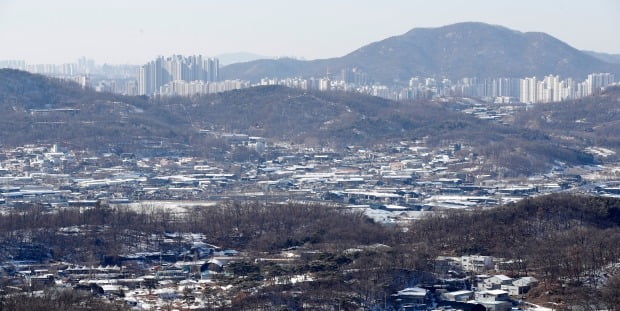Supply of medium-sized housing to Daejeo in Busan and Sanjeong in Gwangju
2·4 Real Estate Measures Follow-up… Follow-up housing site announcement scheduled in April

Gwangmyeong·Siheung area. / Photo = News 1
The government has additionally designated Siheung Gwangmyeong, Daejeo Busan, and Sanjeong Gwangju as the sixth third new city and proposed a plan to supply 101,000 units.
On the 24th, the Ministry of Land, Infrastructure and Transport confirmed and announced the location of about 100,000 units in three places, including Gwangmyeong Siheung (70,000 units), Busan Daejeo (18,000 units), and Gwangju Sanjeong (13,000 units) as a new public housing promotion plan. It is a follow-up measure to the so-called 2·4 real estate countermeasures, which was released on the 4th of the year, the’Gongkong-led 3080+ measures to expand housing supply in large cities. In addition to the first announcement this time, the remaining 150,000 new public housing locations are scheduled to be released in April.
The 3rd new cities announced earlier were Namyangju Wangsuk (Northeast Region), Hanamgyosan (Southeast Region), Goyang Changneung (Northwest Region), Bucheon Daejang and Incheon Gyeyang (Western Region).
The government is planning to foster Gwangmyeong Siheung as a hub city in the southwest region. Gwangmyeong Siheung is located in Gwangmyeong-dong, Okgil-dong, Noonsa-dong, Gahak-dong and Siheung-si Gwarim-dong, Mujinae-dong and Geumi-dong, Gwangmyeong-si, Gyeonggi-do. The area is 12.71 million m2 (approximately 384 million pyeong) and 70,000 houses are expected to be built. It is 4.3 times the area of Yeouido and is the largest among the 3rd new towns. It will be built as a self-sufficient city with the prospect of becoming the 6th large-scale new city in history, including the first and second new cities.
![[속보] Selected as the 6th 3rd new city including Gwangmyeong Siheung... 100,000 units supplied](https://i0.wp.com/img.hankyung.com/photo/202102/01.25499235.1.jpg?w=560&ssl=1)
It is located 12km away from Yeouido, Seoul, inside the Seoul Metropolitan Area First Beltway. The shortest distance from the border of Seoul is only 1km, which is expected to absorb Seoul’s housing demand. Parks, green areas, and waterfront parks of 1.3 times the area of Yeouido (about 3.8 million㎡) will be created. It will secure a park and green space of about 3.8 million m2 (approximately 30% of the area), the largest of the 3rd new towns. An eco-friendly green area system will be established through Mokgamcheon Waterfront Park (extension 7.1km) and a central park for each living area, and a youth culture and exhibition art space will be established nearby.
The transportation network is also expanded. A railroad transportation network will be established that connects lines 1, 2 and 7, the Shinansan Line, which is currently being constructed and planned, the Metropolitan Express Railroad (GTX)-B, and the 2nd Gyeongin Line (including the Guro vehicle base relocation route) under construction. It is planned to reduce the time required to Yeouido via GTX transfer to 20 minutes and 25 minutes to Seoul Station, and to 45 minutes by transferring to Gangnam Station on Line 2.
The government promotes housing supply through mid-sized housing development in the five metropolitan areas, taking into account the situation in the housing market in local areas. In addition to the newly unveiled Busan Daejeo and Gwangju Sanjeong, additional locations will be announced in the future.
Daejeo in Busan will supply 1,800 units in 2.43 million square meters (about 740,000 pyeong) to the entire area of Daejeo-dong, Gangseo-gu, Busan. In order to create a self-sufficient city in connection with the’Busan R&D Special Zone’, the rear residential area will be supplied, and a self-sufficient site of 150,000 square meters will be placed in the adjacent area to strengthen the function of the special zone. The Busan-Gimhae Light Railroad Station will be installed to arrive in Seomyeon within 30 minutes and use the road between Sikman and Sasang to arrive at Busan Station within 20 minutes.
Gwangju Sanjeong will be built in 1.68 million square meters (about 510,000 pyeong) in Sanjeong-dong and Jangsu-dong, Gwangsan-gu, Gwangju. It is 13,000 units. It will supply high-quality residential areas for workers, such as the Bitgreen Industrial Complex in connection with the’Gwangju-type Job Project’, and build a smart logistics and youth entrepreneurship platform. It can be reached within 20 minutes of Gwangju Songjeong Station using Sonjae-ro, etc., and within 20 minutes of Gwangju City Hall and downtown areas when using Mujin-daero.
![[속보] Selected as the 6th 3rd new city including Gwangmyeong Siheung... 100,000 units supplied](https://i0.wp.com/img.hankyung.com/photo/202102/01.25499236.1.jpg?w=560&ssl=1)
The Ministry of Land, Infrastructure and Transport designates these new public residential land candidates as prospective development areas immediately upon public announcement announcement, and regulates the surrounding areas as land transaction permission areas. In the land transaction permission zone, speculative land transactions such as land ownership or superficies are blocked for up to five years. The first new public housing site announced this time will sequentially recruit tenants from 2025.
The Ministry of Land, Infrastructure and Transport is also planning to implement follow-up measures for the new city center project without a hitch. Through the ‘3080+ Integrated Support Center’, which opened on the 17th, it will actively support initial project review, such as business consulting, and will disclose some candidate sites that are willing to participate among the locations proposed by local governments and developers as early as next month.
In May, the first public offering of candidate sites for leading projects for major projects such as public direct implementation maintenance projects and urban public housing complex projects is planned.
An official from the Ministry of Land, Infrastructure and Transport said, “We will prepare a business promotion plan for a housing new deal that solves various social problems such as balanced regional development through a new housing platform,” and “We will reveal specific plans in the first half through consultations with related organizations.”
Hankyung.com reporter Kim Hana [email protected]
